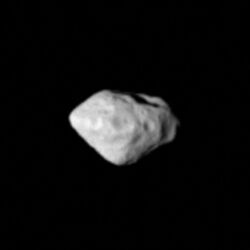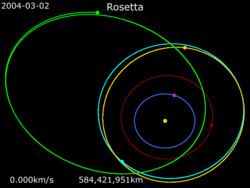Astronomy:2867 Šteins
 Šteins imaged by Rosetta | |
| Discovery [1] | |
|---|---|
| Discovered by | N. Chernykh |
| Discovery site | Crimean Astrophysical Obs. |
| Discovery date | 4 November 1969 |
| Designations | |
| (2867) Šteins | |
| Pronunciation | /ˈsteɪns/ |
| Named after | Kārlis Šteins [1] |
| |
| Minor planet category | |
| Orbital characteristics [2] | |
| Epoch 23 March 2018 (JD 2458200.5) | |
| Uncertainty parameter 0 | |
| Observation arc | 66.47 yr (24,279 d) |
| |{{{apsis}}}|helion}} | 2.7081 AU |
| |{{{apsis}}}|helion}} | 2.0185 AU |
| 2.3633 AU | |
| Eccentricity | 0.1459 |
| Orbital period | 3.63 yr (1,327 d) |
| Mean anomaly | 182.24° |
| Mean motion | 0° 16m 16.68s / day |
| Inclination | 9.9354° |
| Longitude of ascending node | 55.366° |
| 251.08° | |
| Physical characteristics | |
| Dimensions | 6.83 km × 5.70 km × 4.42 km[5] |
| Mean diameter | 4.92±0.40 km[6] 5.160±0.167 km[7] |
| Rotation period | 6.049 h[8][lower-alpha 1] |
| Geometric albedo | 0.300[7] 0.34[6] 0.40[5][9][10] |
| E [8][9][11] V–R = 0.510±0.030[12][13] | |
| Absolute magnitude (H) | 12.7[1][2] 13.36[8][7] 13.36±0.07[6] |
2867 Šteins (provisional designation 1969 VC) is an irregular, diamond-shaped background asteroid from the inner regions of the asteroid belt, approximately 5 kilometers (3.1 miles) in diameter. It was discovered on 4 November 1969 by Soviet astronomer Nikolai Chernykh at the Crimean Astrophysical Observatory in Nauchnij on the Crimean peninsula.[1] In September 2008, ESA's spacecraft Rosetta flew by Šteins, making it one of few minor planets ever visited by a spacecraft. The bright E-type asteroid features 23 named craters and has a rotation period of 6.05 hours.[8] It was named for Soviet Latvian astronomer Kārlis Šteins.[1]
Orbit and classification
Šteins is a non-family asteroid from the main belt's background population.[3][4] It orbits the Sun in the inner asteroid belt at a distance of 2.0–2.7 AU once every 3 years and 8 months (1,327 days; semi-major axis of 2.36 AU). Its orbit has an eccentricity of 0.15 and an inclination of 10° with respect to the ecliptic.[2] The body's observation arc begins with a precovery, taken at the Palomar Observatory in November 1951, or 18 years prior to its official discovery observation.[1]
Naming
This minor planet was named in memory of Kārlis Šteins (1911–1983), a Latvian and Soviet astronomer. He was a long-time observatory director at the University of Latvia in Riga and designed astronomical instruments. Šteins is known for his work on cometary cosmogony and the study of Earth's rotation.[1] The official naming citation was published by the Minor Planet Center on 18 September 1986 (M.P.C. 11157).[14]
Features on Šteins
On 11 May 2012, IAU's Working Group for Planetary System Nomenclature announced a naming system for geographical features on Šteins.[15] Inspired by the asteroid's gem-like shape, its crater are given the English-language names of precious stones, with the largest being named Diamond crater (see below).
Except for the montes of Mercury and the lunar maria (and proposed for 2 Pallas and 7 Iris), the craters of Šteins are the only features in the Solar System whose names are not derived from proper nouns.[16] In addition, a distinct region on the asteroid has been named Chernykh Regio after the discoverer, Nikolai Chernykh.[17]
Physical characteristics
A study published in 2006 by astronomers at the European Southern Observatory showed that Šteins is an E-type asteroid with a diameter of approximately 4.6 kilometers.[9] After the Rosetta flyby, the ESA described Šteins as a "diamond in the sky", as it has a wide body that tapers into a point. The wide section is dominated by the large Diamond crater with a diameter of 2.1 kilometers, which surprised scientists, who were at first amazed the asteroid survived such an impact,[18] while later it turned out that the crater-to-body diameter ratio of 0.79 is in fact not abnormally large as it follows an already established trend.[19] Besides its irregular in shape, it does not have any moons.[20]
Diameter and albedo
According to the survey carried out by the NEOWISE mission of NASA's Wide-field Infrared Survey Explorer and observations by the Spitzer Space Telescope, Šteins measures 5.16 and 4.92 kilometers in diameter and its surface has an albedo of 0.30 and 0.34, respectively.[6][7] Its overall Bond albedo is 0.24 ± 0.01.[21] In 2012, the photographs of Šteins taken by Rosetta using stereophotoclinometry allowed scientists to determine that the asteroid's dimensions are 6.83 × 5.70 × 4.42 kilometers, which equates to a mean diameter in volume of 5.26 km.[5] (Asteroid 129167 Dianelambert was later named for the scientist using this 3D-method.) The Collaborative Asteroid Lightcurve Link adopts an albedo of 0.34 and a diameter of 4.9 kilometers with an absolute magnitude of 13.36.[8]
Lightcurves and poles
Studying the asteroid with Rosetta space probe onboard OSIRIS cameras shortly before its flyby showed via a lightcurve analysis that Šteins has a rotation period of 6.052±0.007 hours.[22][20] The results of the rotational lightcurve agree with ground-based photometric observations of Šteins with a period of 6.049 hours and a brightness amplitude between 0.18 and 0.31 magnitude ({{{1}}}).[8][10][12][13][23][24][lower-alpha 1]
A lightcurve inversion also modeled a concurring sidereal period of 6.04681 hours and determined a spin axis at (250.0°, −89.0°) in ecliptic coordinates (λ, β). The modeling was done by compiling a set of 26 previously obtained visible lightcurves.[25]
Exploration
Rosetta flyby
On 5 September 2008, the Rosetta space probe flew by Šteins at a distance of 800 km and a relatively slow speed of 8.6 km/s. Despite the short duration of this encounter (approximately 7 minutes in total), a great amount of data was obtained by the 15 scientific instruments operating on board the Rosetta spacecraft.[26] This was the first of two planned asteroid flybys performed by the probe, the second being to the much larger 21 Lutetia in 2010.[27] The timing of the fly-by meant that the asteroid was illuminated by the sun from the perspective of the spacecraft, making the transmitted images clear. The European Space Operations Centre streamed a press conference on Šteins later that day.[28]
See also
- List of craters on minor planets
- List of minor planets and comets visited by spacecraft
Notes
- ↑ 1.0 1.1 Lightcurve plot of 2867 Steins, Palmer Divide Observatory by B. D. Warner (2004). Rotation period of 6.05±0.01 hours with a brightness amplitude of 0.30 mag. Quality code is 3-. Summary figures for (2867) Šteins at the LCDB.
References
- ↑ 1.0 1.1 1.2 1.3 1.4 1.5 1.6 1.7 "2867 Steins (1969 VC)". Minor Planet Center. https://www.minorplanetcenter.net/db_search/show_object?object_id=2867.
- ↑ 2.0 2.1 2.2 2.3 "JPL Small-Body Database Browser: 2867 Steins (1969 VC)". Jet Propulsion Laboratory. https://ssd.jpl.nasa.gov/sbdb.cgi?sstr=2002867.
- ↑ 3.0 3.1 "Asteroid (2867) Steins – Proper elements". AstDyS-2, Asteroids – Dynamic Site. https://newton.spacedys.com/astdys/index.php?n=2867&pc=1.1.6.
- ↑ 4.0 4.1 "Asteroid 2867 Steins". Small Bodies Data Ferret. https://sbntools.psi.edu/ferret/SimpleSearch/results.action?targetName=2867+Steins.
- ↑ 5.0 5.1 5.2 Jorda, L.; Lamy, P. L.; Gaskell, R. W.; Kaasalainen, M.; Groussin, O.; Besse, S. et al. (November 2012). "Asteroid (2867) Steins: Shape, topography and global physical properties from OSIRIS observations". Icarus 221 (2): 1089–1100. doi:10.1016/j.icarus.2012.07.035. Bibcode: 2012Icar..221.1089J.
- ↑ 6.0 6.1 6.2 6.3 Lamy, P. L.; Jorda, L.; Fornasier, S.; Groussin, O.; Barucci, M. A.; Carvano, J. et al. (September 2008). "Asteroid 2867 Steins. III. Spitzer Space Telescope observations, size determination, and thermal properties". Astronomy and Astrophysics 487 (3): 1187–1193. doi:10.1051/0004-6361:20078996. Bibcode: 2008A&A...487.1187L.
- ↑ 7.0 7.1 7.2 7.3 Mainzer, A. K.; Bauer, J. M.; Cutri, R. M.; Grav, T.; Kramer, E. A.; Masiero, J. R. et al. (June 2016). "NEOWISE Diameters and Albedos V1.0". NASA Planetary Data System: EAR-A-COMPIL-5-NEOWISEDIAM-V1.0. Bibcode: 2016PDSS..247.....M. https://sbnarchive.psi.edu/pds3/non_mission/EAR_A_COMPIL_5_NEOWISEDIAM_V1_0/data/neowise_mainbelt.tab. Retrieved 31 August 2018.
- ↑ 8.0 8.1 8.2 8.3 8.4 8.5 "LCDB Data for (2867) Šteins". Asteroid Lightcurve Database (LCDB). http://www.minorplanet.info/PHP/generateOneAsteroidInfo.php?AstInfo=2867%7CŠteins.
- ↑ 9.0 9.1 9.2 Fornasier, S.; Belskaya, I.; Fulchignoni, M.; Barucci, M. A.; Barbieri, C. (April 2006). "First albedo determination of 2867 Steins, target of the Rosetta mission". Astronomy and Astrophysics 449 (2): L9–L12. doi:10.1051/0004-6361:20064913. Bibcode: 2006A&A...449L...9F.
- ↑ 10.0 10.1 Hicks, M. D.; Bauer, J. M.; Tokunaga, A. T. (April 2004). "(2867) Steins IAUC 8315". IAU Circ. 8315 (8315): 3. Bibcode: 2004IAUC.8315....3H. http://www.cbat.eps.harvard.edu/iauc/08300/08315.html#Item3. Retrieved 31 August 2018.
- ↑ Belskaya, I. N.; Fornasier, S.; Tozzi, G. P.; Gil-Hutton, R.; Cellino, A.; Antonyuk, K. et al. (March 2017). "Refining the asteroid taxonomy by polarimetric observations". Icarus 284: 30–42. doi:10.1016/j.icarus.2016.11.003. Bibcode: 2017Icar..284...30B.
- ↑ 12.0 12.1 Weissman, Paul R.; Lowry, Stephen C.; Choi, Young-Jun (August 2005). "CCD Photometry of Asteroid 2867 Steins: Flyby Target of the Rosetta Mission". American Astronomical Society 37: 644. Bibcode: 2005DPS....37.1528W.
- ↑ 13.0 13.1 Dotto, E.; Perna, D.; Fornasier, S.; Belskaya, I. N.; Barucci, M. A.; Shevchenko, V. G. et al. (February 2009). "Photometric and spectroscopic investigation of 2867 Steins, target of the Rosetta mission. Ground-based results prior to the Rosetta fly-by". Astronomy and Astrophysics 494 (3): L29–L32. doi:10.1051/0004-6361:200811340. Bibcode: 2009A&A...494L..29D.
- ↑ "MPC/MPO/MPS Archive". Minor Planet Center. https://www.minorplanetcenter.net/iau/ECS/MPCArchive/MPCArchive_TBL.html.
- ↑ "First Names Approved for Asteroid (2867) Steins". USGS–Astrogeology Science Center. https://astrogeology.usgs.gov/news/nomenclature/first-names-approved-for-asteroid-2867-steins.
- ↑ "Gazetteer of Planetary Nomenclature–Categories for Naming Features on Planets and Satellites". IAU–Working Group for Planetary System Nomenclature (WGPSN). http://planetarynames.wr.usgs.gov/Page/Categories.
- ↑ "Target: Steins". IAU–Working Group for Planetary System Nomenclature (WGPSN). http://planetarynames.wr.usgs.gov/Page/STEINS/target.
- ↑ "Steins: A diamond in the sky". ESA Rosetta News. http://www.esa.int/SPECIALS/Rosetta/SEMNMYO4KKF_0.html.
- ↑ Burchell, M. J.; Leliwa-Kopystynski, J. (December 2010). "The large crater on the small Asteroid (2867) Steins". Icarus 210 (2): 707–712. doi:10.1016/j.icarus.2010.07.026. Bibcode: 2010Icar..210..707B. https://hal.archives-ouvertes.fr/hal-00693824/document. Retrieved 31 August 2018.
- ↑ 20.0 20.1 Michael Küppers; Uwe Keller (20 March 2007). "OSIRIS camera on Rosetta obtains 'light curve' of asteroid Steins". European Space Agency. http://www.esa.int/SPECIALS/Rosetta/SEMCC2R08ZE_0.html.
- ↑ Spjuth, S.; Jorda, L.; Lamy, P. L.; Keller, H. U.; Li, J.-Y. (November 2012). "Disk-resolved photometry of Asteroid (2867) Steins" (in en). Icar 221 (2): 1101–1118. doi:10.1016/j.icarus.2012.06.021. ISSN 0019-1035. Bibcode: 2012Icar..221.1101S.
- ↑ Küppers, M.; Mottola, S.; Lowry, S. C.; A'Hearn, M. F.; Barbieri, C.; Barucci, M. A. et al. (January 2007). "Determination of the light curve of the Rosetta target asteroid (2867) Steins by the OSIRIS cameras onboard Rosetta". Astronomy and Astrophysics 462 (1): L13–L16. doi:10.1051/0004-6361:20066694. Bibcode: 2007A&A...462L..13K.
- ↑ Warner, Brian D. (September 2004). "Lightcurve analysis for numbered asteroids 301, 380, 2867, 8373, 25143, and 31368". The Minor Planet Bulletin 31 (3): 67–70. ISSN 1052-8091. Bibcode: 2004MPBu...31...67W.
- ↑ Weissman, P. R.; Lowry, S. C.; Choi, Y.-J. (May 2007). "Photometric observations of Rosetta target asteroid 2867 Steins". Astronomy and Astrophysics 466 (2): 737–742. doi:10.1051/0004-6361:20066409. Bibcode: 2007A&A...466..737W.
- ↑ Lamy, P. L.; Kaasalainen, M.; Lowry, S.; Weissman, P.; Barucci, M. A.; Carvano, J. et al. (September 2008). "Asteroid 2867 Steins. II. Multi-telescope visible observations, shape reconstruction, and rotational state". Astronomy and Astrophysics 487 (3): 1179–1185. doi:10.1051/0004-6361:20078995. Bibcode: 2008A&A...487.1179L.
- ↑ "Encounter of a different kind: Rosetta observes asteroid at close quarters". ESA Rosetta News. http://www.esa.int/SPECIALS/Rosetta/SEM5EZO4KKF_0.html.
- ↑ M. A. Barucci; M. Fulchignoni; A. Rossi (2007). "Rosetta Asteroid Targets: 2867 Steins and 21 Lutetia". Space Science Reviews 128 (1–4): 67–78. doi:10.1007/s11214-006-9029-6. Bibcode: 2007SSRv..128...67B.
- ↑ Talevi, Monica (4 September 2008). "Rosetta Steins fly-by timeline". European Space Agency. http://www.spaceref.com/news/viewpr.html?pid=26345.
External links
- Steins: A diamond in the Sky, images, ESA
- Asteroids and comets rotation curves – (2867) Šteins – Observatoire de Genève, Raoul Behrend
- Rosetta's OSIRIS cameras reveal the nature of asteroid Steins, ESA, January 2010
- Asteroid Lightcurve Database (LCDB), query form (info)
- Dictionary of Minor Planet Names, Google books
- Discovery Circumstances: Numbered Minor Planets (1)-(5000) – Minor Planet Center
- 2867 Šteins at AstDyS-2, Asteroids—Dynamic Site
- 2867 Šteins at the JPL Small-Body Database
 |


